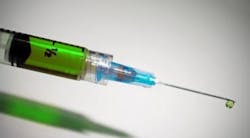Pharmaceutical manufacturers seeking systems and methods to improve the performance of syringe filling and packaging equipment have many factors to consider. In an environment characterized by increasingly demanding production requirements driven by machinery composed of numerous mechanical parts, choosing the most efficient plastics and sealing components can be daunting.
Seals designed for leakage control and components such as guide rails, turning pucks and holders used in syringe filling play a critical role across the entire production process. When these parts fail, interruptions can be costly. However, much of this lost time can be avoided with careful consideration and selection of the right plastic and seals for the task.
Some noteworthy trends have emerged in these areas to help manufacturers conserve precious time and resources.
Plastic materials
The pharmaceutical processing environment is strictly regulated, requiring the highest integrity products composed of industry-compliant materials. Products designed and composed of Ultra-High-Molecular-Weight Polyethylene (UHMW) with its tough, low-friction properties are an industry standard.
The introduction of new PTFE-filled material, custom-blended for pharmaceutical processing applications, offers manufacturers a very durable, low-friction, chemically inert material option. PTFE-filled material is also designed for high performance in five additional areas important for pharmaceutical processing — wear resistance, heat transfer, mechanical strength, extrusion resistance and thermal conductivity.
Materials formulated for development of longer-life plastic and sealing products help reduce the occurrence of failures. Since a filling machine can process thousands of syringes nonstop, any downtime saved is significant.
Sealing products
Spring energized seals, piston seals, U-cups and wipers are some of the most common seals used in syringe filling and packaging applications. Each seal performs an important function.
Spring energized seals address challenges associated with managing chemicals and temperature. The seals are manufactured with a U-shaped jacket employing a metal spring that actuates the jacket material for sealing at low pressures. At higher pressures, the seal is further energized by the fluid media. Use of a silicone-filled cavity prevents fluid media from contacting the spring, which is a great benefit for sterile environments.
Piston seals prevent pressurized fluid leaks, and U-cups are used in a wide range of applications to hold pressure. In a powder production environment, for example, a U-cup can hold low pressures with great flexibility, provided the proper material and profile is selected.
Wipers prevent contaminants such as dirt, dust and moisture from entering a machine’s hydraulic or pneumatic cylinder system. Contamination is one of the primary causes of premature seal and component failure.
Today, a one-piece product is available that incorporates seals, bearings and pistons in a single housing. This gives pharmaceutical manufacturers a more streamlined solution for installation repeatability. By reducing the number of moving parts, the one-piece product also offers significant reduction in washdown and maintenance time.
Adapting machines
Increased demand for variety in syringe sizes has led to a heightened interest in machinery assessment for expanded use. When a pharmaceutical manufacturer partners with a plastics and sealing vendor adept in engineering design, OEM equipment can be modified at a fraction of the cost of new machinery.
This was the case for one global veterinary pharmaceutical manufacturer who modified a piece of equipment that was limited by its original design to process a single syringe. Now, the manufacturer can run several different size syringes on the same machine.
Using the latest 3-D modeling technology supported by CAD/CAM on CNC machinery, custom-molded PTFE and plastic parts can be designed and produced in a matter of days. The engineer’s ability to design the parts using the proper materials and knowledge of tolerances is critical for successful parts to be made. Before these parts are put into use in a processing facility, test rigs are used to simulate real-world functionality and ensure product performance. This approach provides yet another means to conserve time and cut costs.
Conclusion
Plastic materials, sealing products and machinery adaptation for expanded use are topics that will continue to trend. As pharmaceutical manufacturers navigate challenges faced in these areas, the following points will help them select the right seals for their operations:
1. Materials matter. It is important to select a material that has good wear characteristics, offers flexibility in mounting and maintenance, and is also compatible with the contacting media during wash down or the cleaning-in-place process.
2. All pharma sealing products are not created equal. Although most sealing problems can be fixed with a universal O-ring, selecting the proper seal profile, such as a wiper for contamination control, is important to improving the effectiveness of the seal and ensuring reduced overall maintenance. Each sealing profile is designed differently to deliver best performance under given conditions.
3. Seals should be as flexible and adaptable as the equipment and machinery on which they operate. Careful consideration should be given to the installation of the seals and gland that they fit in. A seal fitted into a closed gland should be flexible enough to allow its shape to be distorted and not permanently damaged during installation. It is sometimes easier to use installation tools that allow seals to be resized to their original shape when installed and ensure the sealing lips are in the correct orientation prior to operating.
[javascriptSnippet]






